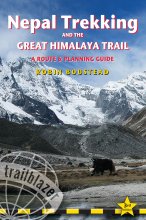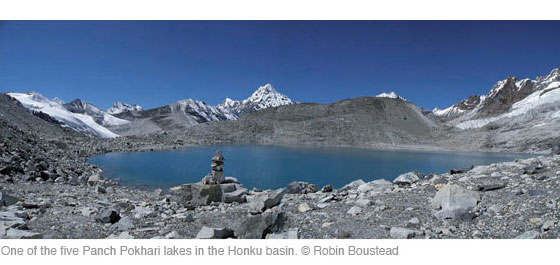Trailblazer Guides are produced by people who know exactly what information is needed - not just to get from A to B but to be entertaining as well as informative.
— The Great Outdoors

Nepal Trekking and The Great Himalaya Trail
Excerpt:
Introduction
Contents | Introduction | Planning your trek: trekking styles | Route Guide: main trekking areas | Kanchenjunga region
INTRODUCTION
The Nepal Himalaya is amazing; a place where you can immerse yourself in cultures little changed by the modern world and be inspired by the greatest mountain scenery on the planet.
Since the early 1950s, trekkers have been exploring the countless valleys and peaks of the mid-hills, pahar, and high ranges, himal, throughout Nepal. Recent elections and relative political stability have led to a surge in visitors and the mountains once again offer unhindered trails for anyone to explore.
The three main trekking regions, Everest (Solu-Khumbu), Annapurna and Langtang attract over 160,000 trekkers every year but represent less than a quarter of Nepal’s himals.
If you want a little luxury, facilities have never been better along these major trekking routes, sometimes rivalling those found in Europe or elsewhere. Trails are well maintained and safe, and locals will welcome you with a genuine friendliness that will make your heart melt.
The other three-quarters of Nepal’s mountain terrain is considered ‘off-the-beaten-track’ and often counts visitors in mere dozens. From the lush rhododendron forests of the east to the dense woodlands of the west the himals form a wilderness interspersed with remote communities that have remained relatively untouched.
In these regions, a small trekking group can make a real difference to lives that often barely subsist. Although the mountains are beyond compare, it is the people you meet along the trail who linger in your memory.
You can’t help but admire their indefatigable boldness and energy, their independence, strength and resilience when times are bad, and their fun, open-hearted, generous nature towards strangers who may never return. It’s impossible to make a comparison, but surely the people of the Himalaya are the very best of mankind?
In 2002, the Nepali government reconciled all border disputes with its northern neighbour China. This de-militarised seven border areas and for the first time in over fifty years tourists were allowed to explore them.
All these areas offer unique trekking opportunities, with many resembling the now popular regions as they were thirty or more years ago. They also tend to be next to the major trekking routes so it’s possible to design itineraries combining old and new routes thus making your holiday a more ‘complete’ Nepali experience.
For many years, one of the great trekking ‘holy grails’ has been a route through the remotest peaks of the entire Himalaya, linking all the major trekking regions. The author is the first person to survey, plot and describe such a route: the Great Himalaya Trail (GHT).
The Nepal section of the GHT can take 90 to 160 days of walking, so for convenience it is broken into sections, all of which have easy access and lower route alternatives through the pahar.
The introduction of new trekking routes through remote communities will encourage micro-tourism projects in places that are too remote for intensive infrastructure development.
By creating value in regions that previously had little to offer for tourism, it is hoped that the relevant government departments will establish a network of National Parks and Conservation Areas as a trans-boundary corridor for animal migration, which could reduce illegal hunting and help save many endangered species. The snow-covered crown of Asia may then become one of its greatest assets.

Background to the GHT
The Great Himalaya Trail runs through regions and countries that have cultures dating back thousands of years, and for much of the time they have been trading with each other across the mountains.
Salt, wood, grains, wool and livestock, gold and gems are just a few of the products that helped to establish a network of trails from Indochina to Afghanistan, including sections of the famous Silk Route.
It is easy to imagine local traders plying trails with their yak or donkey trains throughout the region. Over centuries, they explored remote valleys trying to find the easiest trails over the never-ending ‘Abode of Snow’, the Himalaya.
In the larger valleys small communities sprang up and developed their own unique languages and traditions. For over a thousand years the people of the Himalaya were cut off from the rest of the world as Ladakh, Nepal, Sikkim, Bhutan and Tibet all kept their borders closed from prying, colonial eyes.
Jesuit missionaries were the first Europeans to penetrate deep into the Himalaya, in the early seventeenth century. The first was Father Antonio Andrade, in 1626, who crossed from India to western Tibet and then enjoyed the local Tibetans’ open-minded hospitality that still exists today.
However, it is William Moorcroft who is considered the father of modern Himalayan exploration. His first trip, in 1812, was in search of Tibetan goats to trade cashmere; another followed this in 1819-25, when he disappeared without a trace.
In his wake came a long succession of missionaries, botanists, geographers and traders who criss-crossed the mountain ranges from east to west and began mapping the himals. Exploration activity increased from the 1850s with the Great Game, a period when the British Raj, Russian Tsar and Chinese Qing empires all vied for ascendancy in the region.
The then new sport of mountain-climbing arrived in the Himalaya in the 1880s with WW Graham, Sir Martin Conway and Douglas William Freshfield who pushed deep into the unexplored valleys of Sikkim and the Karakorum.
However, most of the Himalayan Kingdoms still discouraged visitors, leaving many areas ‘blanks on the map’. After the First World War, a number of expeditions were organised to reconnoitre and climb significant peaks.
However, it was the mysterious disappearance of Mallory and Irvine on Mt Everest in 1924 that really ignited the world’s imagination for Himalayan exploration, and was a precursor to the successful expedition led by Lord Hunt that placed Sir Edmund Hillary and Tenzing Norgay on the summit on 29th May 1953.
It was the research expeditions to identify new peaks and climbing routes that began what we now call ‘trekking’. In 1949, WH (Bill) Tilman visited the Helambu, Langtang, Kali Gandaki valley and Everest regions intent on walking through valleys rather than climbing any specific peak, and so became the first Himalayan ‘trekker’.
In 1965, Colonel Jimmy Roberts introduced the world to organised trekking holidays and began a revolution in adventure holidays that made regions of the Himalaya accessible to anyone.
All of the activity to date was largely north to south across the Himalayan ranges, so when an east to west route along the entire range was suggested in the 1970s it was considered a radical idea. Yet the challenge had been set: who could be the first to traverse the entire range?
At the time, the eastern ranges through Bhutan and Tibet were closed so the first attempts could only start in Sikkim, an autonomous region of India. The first attempted Himalaya traverse was in 1980 with Harish Kohli leading an Indian Army team who operated in relay.
However, the first unbroken traverse was by Peter Hillary (son of Sir Edmund), Graeme Dingle and SP Chamoli in 1981 (they told their story in First Across the Roof of the World). Both treks began at Kanchenjunga, on the border of Nepal and Sikkim and ended in or near Concordia at the base of K2 (Pakistan border).
A nine-month trek over 1981-82 saw Hugh Swift and Arlene Blum complete a traverse from Bhutan to Ladakh in India (Blum documented her story in Breaking Trail). In 1983, the Crane brothers (Adrian and Richard) ran 3200km (2000 miles) from Darjeeling (Sikkim) to Pakistan, thus setting a record, which has yet to be broken (the Crane’s story is told in Running the Himalayas).
This was to remain the longest attempt until 1990, when Sorrell Wilby and her husband, Chris Ciantar, made a traverse from Pakistan to Arunchal Pradesh (northern Assam in India), which included nearly every Himalayan region (documented in Wilby’s book, Across the Top).
In 1994, the French duo of Paul-Eric Bonneau and Bruno Poirier crossed the Nepal Himalaya in 42 days (October 21 to December 1, 1994) from Pashupatinagar to Mahakali (see their book, Trans-Nepal-Himalaya).
Then, in 1997, two Frenchmen, Alexandre Poussin and Sylvain Tesson, embarked on an epic adventure along the Himalaya (Bhutan to Tajikistan) that involved getting arrested in three countries – Tibet, Pakistan and Tajikistan. Their journey (published as La Marche dans le Ciel) really pushed the boundaries of what was considered to be ‘Himalayan’.
Since 1997, there have been many attempts traversing the Himalaya by walking, running and biking, but all these expeditions suffered from restrictions on where they could visit. Closed and restricted areas meant trekkers often had to detour to the pahar, away from the Great Himalaya Range.
Even Nepal, perhaps the most accessible of the countries, had strict ‘no-go’ areas along the border with Tibet. In 2002, things changed and Nepal opened every one of its himals to permit-based trekking. Along with new trekking areas in Bhutan and India, the Great Himalaya Range was completely open to trekkers for the first time in history.
The first person to take advantage of the newly-opened regions of Nepal was Rosie Swale-Pope, who ran the length of Nepal in 2003. Her 1700km route from Taplejung to Simikot was an early precursor to the current Great Himalaya Trail concept.
Dr Gillian Holdsworth walked a similar route in 2007, which is documented on the British Nepal Medical Trust website.
From early 2004, Robin Boustead (the author of this guide, www.greathimalayatrail.com) systematically researched and documented each of the newly opened trekking regions over four years, culminating in a 162-day Great Himalaya Trail high traverse of Nepal’s himals from September 2008 to July 2009.
Between 2008 and 2011 Jean-Claude Latombe walked across Nepal in two sections of 56 and 53 days and his website (http://ai.stanford.edu/~latombe) has a wonderful collage of images of the people and landscapes he encountered.
In 2010 another adventurer, Sean Burch, completed a route across Nepal in 49 days with the support of the Nepal Trust, and in 2011 Shawn Forry and Justin Lichter walked and ran an unsupported trek of 57 days across Nepal.
Each of these documented journeys was different, a clear example of how the Great Himalaya Trail is a personal challenge along a trail system that allows you to develop your own route priorities and set your own goals.
Treks can be as short as just 5 or 6 days at low elevation through to extreme journeys of months at high altitude. For some, the ultimate Great Himalaya Trail challenge follows a trail network that links the ‘highest feasible route’ along the length of the various himals.
However, weather and time restrictions mean that trekkers often choose sections that bypass technical passes or navigation-problem areas. So linking village trails with higher routes has become the accepted norm when designing itineraries.
The GHT has become a way to immerse yourself in Himalayan cultures and challenge your boundaries – there truly is a trail for everyone!
Nepal Trekking and The Great Himalaya Trail
Excerpts:
- Contents
- Introduction
- Planning your trek: trekking styles
- Route Guide: main trekking areas
- Kanchenjunga region
Price: £15.99 buy online now…
Latest tweets